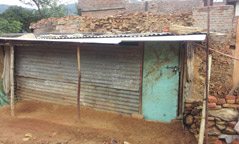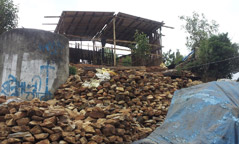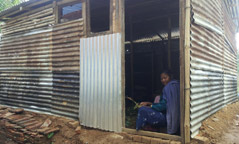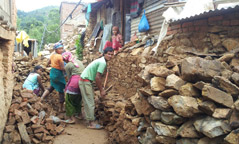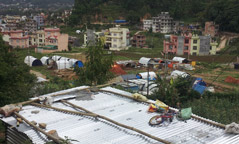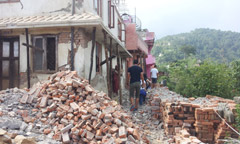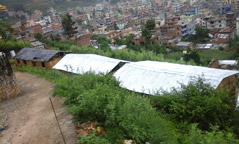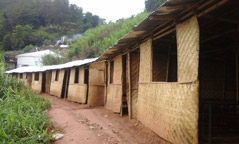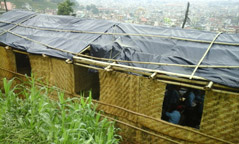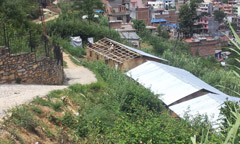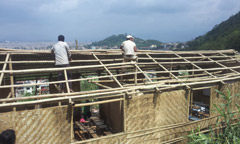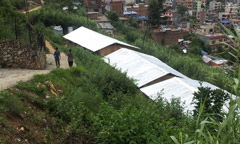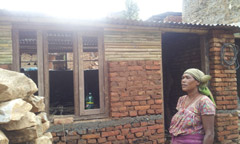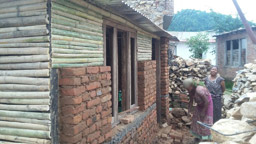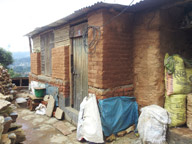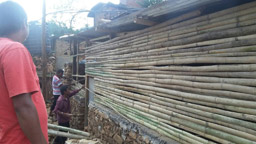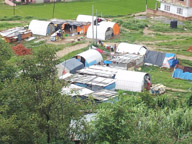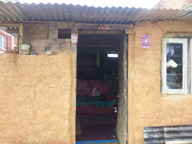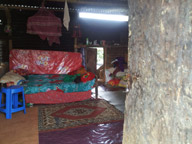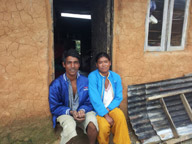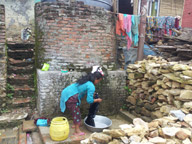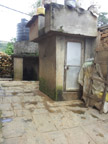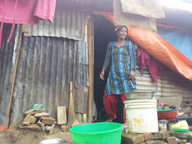(Halcok or Halchok? We're going with Halchok* [1How is the village’s name pronounced? It’s Hal (“open the pod door, Hal”) + choke. In formal Devanagari transliteration it is spelled Halcok, but too many people think that should be pronounced Halkoke (with the coke as in coal or coca-cola), so we’re going with Halchok (which is the “informal” transliteration) from now on.])
(click on thumbnails to see larger images)
In the two months since our last update of June 22 our efforts have been concentrated on supplying and installing the corrugated metal roofing, jastha, to the Halchok villagers for their temporary housing. Since Ian left Nepal in June, Manika Rai, our project manager in Kathmandu, has visited weekly and recorded the progress of the work and consulted with Sukri Putuwar and Buddhi Bahadur Shahi about supplies and further work to be done, and has kept and recorded the project accounts (the photos in this update are hers). Sukri Putuwar, has ordered and arranged delivery of the jastha (corrugated roofing) and bamboo, and overseen the distribution and organized the building. The villagers themselves, who cooperate on building each structure, are carrying out the building work. The villagers decided to build the temporary structures in the village itself, in each family’s original lot.
But the process of building the temporary shelters is slowed by the scarcity of jastha in the market, and many of the villagers are still camped behind and below the village, while they clear their lots and wait for new supplies of roofing.
Even though some of the better-off villagers had managed to build houses with bricks and cement, and most of these structures remained standing after the earthquake (thus doing what a house should in an earthquake!), most are damaged beyond repair. So these villagers are faced with having to destroy their original house before starting again, a situation which faces many in Nepal's middle class.
The village school:
The village school buildings survived the earthquakes without collapsing, but parents and students do not want to use them because of uncertainty regarding the safety of the structures. So the village school has been relocated to temporary structures on the hill in front of and below the village. Individual classroom buildings are made of bamboo frames with light jastha roofs and rattan mat walls. The government provided these supplies. But the supplies ran out for the last classroom.
We all decided that we'd contribute a good roof for the last classroom building as soon as we could get some more jastha. The main obstacle has been lack of access to supplies, as we reported in our last update. Since the earthquake, supplies of relief supplies and building supplies such as jastha have lagged far behind demand, and it often takes weeks for an order to be filled. Since the first delivery of the first batch of corrugated metal roofing on June 7th, we had to wait for a month to get the second, which was delivered on July 5th. And then we had to wait for a week while the quality was verified. Once the second shipment of roofing had been delivered and verified, Sukri and his crew immediately went to work to roof the last classroom structure of the school:
With the July shipment of jastha, work continued on the villagers' temporary shelters, constructed on their old home sites. Our project has supplied the bamboo for framing and the new corrugated metal roofing. The villagers themselves have done the rest, constructing walls from old metal roofing, recovered bricks, and split bamboo.
As more villagers return to their home sites, there are fewer shelters below the village. Gradually the village is reappearing from the rubble. The water system has been repaired and is working, and there are enough working toilets to allow access to all.
We are now waiting for our third shipment of jastha, ordered weeks ago. Previously the delays in delivery have centered on shortages of this building material, needed for the construction of housing throughout the earthquake zone. The scarcity has recently been exacerbated by political unrest, which again plagues Nepal. Politicians calling for an ethnic division of the country into smaller, more ethnically designated, and more numerous, zones than those agreed upon by the major parties, have called for nationwide strikes, and these strikes (bandhs) have shut down the national transport system, particularly in the Terai, the southern area of the country bordering India. Since most of the corrugated roofing comes from India or from factories in the Terai, the Kathmandu valley has experienced an even more severe shortage of these supplies, which has hampered our work.
We are hopeful that we will get the next shipment of jastha within the next few days and the final stages of building shelter for all villagers can continue. In the meantime, the majority of the villagers have shelter at their own home plots, while the rest, awaiting the next shipments, are still sheltered in makeshift shelters below the village; while they wait for roofing, they are working to clean and prepare their former home sites.
Ian and Lois are planning their trip to Kathmandu in mid-October. The main activity at the present is to research and find new possible solutions for the village when they are ready to rebuild, so that they can then "build back better" by adding useful, but readily available, upgrades to their present system of building that will help ensure the buildings will not collapse in the next earthquake as they did in April.
We feel it is important to attempt to succeed in that goal without attempting to overturn the village traditional building materials – inexpensive and thus accessible – of undressed stone and mud mortar. Upgrading this ancient technique through supplying the villagers with some readily available, but more expensive, and thus less accessible building materials, such as wire mesh and good lumber, has a chance of greatly increasing the earthquake resistance of their houses if done well. That is our late summer challenge.[2There are very interesting answers to this challenge appearing which will be very useful. Perhaps the most interesting approach is that of Randolph Langenbach in his website: www.traditional-is-modern.net/Nepal.html
of particular interest is his preliminary paper on rural stone houses in Nepal: www.traditional-is-modern.net/NEPAL/RLCorrespondanceReports/ReconstructingRuralStoneHouses(Langenbach)v2.pdf ]
Ian and Lois and Vasundhara and Vajra Alsop, Santa Fe
Manika Rai, program director, (and photographer) Kathmandu
Elizabeth Winthrop, fund raiser extraordinaire, New York
Sukri and the builders, and all the villagers of Halchok
Sameer Tuladhar, Asianart.com, Halchok pages webmaster
